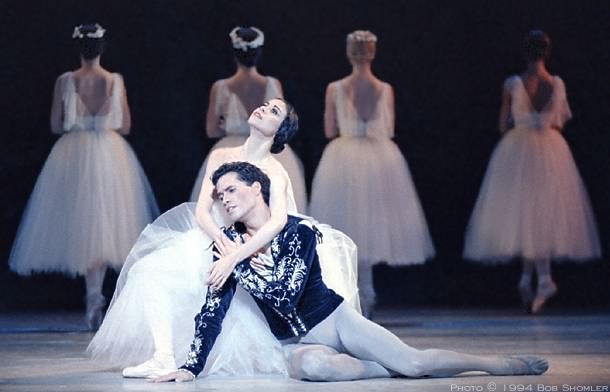
Photo Bob Shomler
San Jose Cleveland Ballet in Giselle
The story of Giselle (1841), like that of other ballets from the Romantic period, is taken from a legend. The libretto was written by Théophile Gautier (1811 - 1872), based on a work of the great German poet Henrich Heine (1797 - 1856).
In the second act, the bereaved Albrecht goes to Giselle’s grave. Despite the disguise he was sincerely in love with her. The ghost of Giselle rises from the grave, transformed into a Willy.
The variety of situations, some of them supernatural, and the flow of emotions, typical of the Romantics, are difficult to interpret convincingly, even for the greatest dancers.
Through the centuries dancers have faced the difficulties that these stories present: the challenge of rendering this material believable. This sense of reality is essential for the most representative ballet of the Romantic period, Giselle.
In Giselle, Prince Albrecht disguises himself as a commoner and presents himself as a rival to the suitor Hilarion for the hand of a common girl, Giselle. Albrecht promises his love to her and the two lovers dance joyfully.
Giselle’s mother reminds her not to exert herself too much, as her health is delicate. After a short time, Albrecht is unmasked and it is revealed that he has already promised to marry another noblewoman. Giselle loses her mind and dies.
Willies are unhappy spirits of young girls who were abandoned and died before their wedding day. They leave their graves during the night to look for revenge. Albrecht wanders into the enchanted woods where they meet, but any mortal that invades this supernatural domain is condemned to death. The Willies try to make Albrecht dance until he dies of exhaustion, but Giselle intercedes and saves the prince’s life.
Support our site: shop at our store for dance related books, CDs, DVDs, toys, gifts and more…
The story of Giselle differs from other Romantic ballets. In Giselle there is more emphasis on personality, and the idea of translating emotion and sincerity in dance takes on new importance. The dancers must create and sustain a believable characterization of the figure they represent. More than any other ballet, Giselle has taught dancers to be actors as well.
Certainly the best loved Romantic ballet, Giselle is popular for the music composed by Adolphe Adam (1803 - 1856), and the expressive and ethereal choreography of Jean Corelli (1779 - 1858) and Jules Joseph Perrot (1810 - 1892).

Photo Bob Shomler
Art & Dance Factory a.s.d. - Via della Chiesa, 37, Calenzano FI - C.F. 94261640489 - tel. 338/6577008
